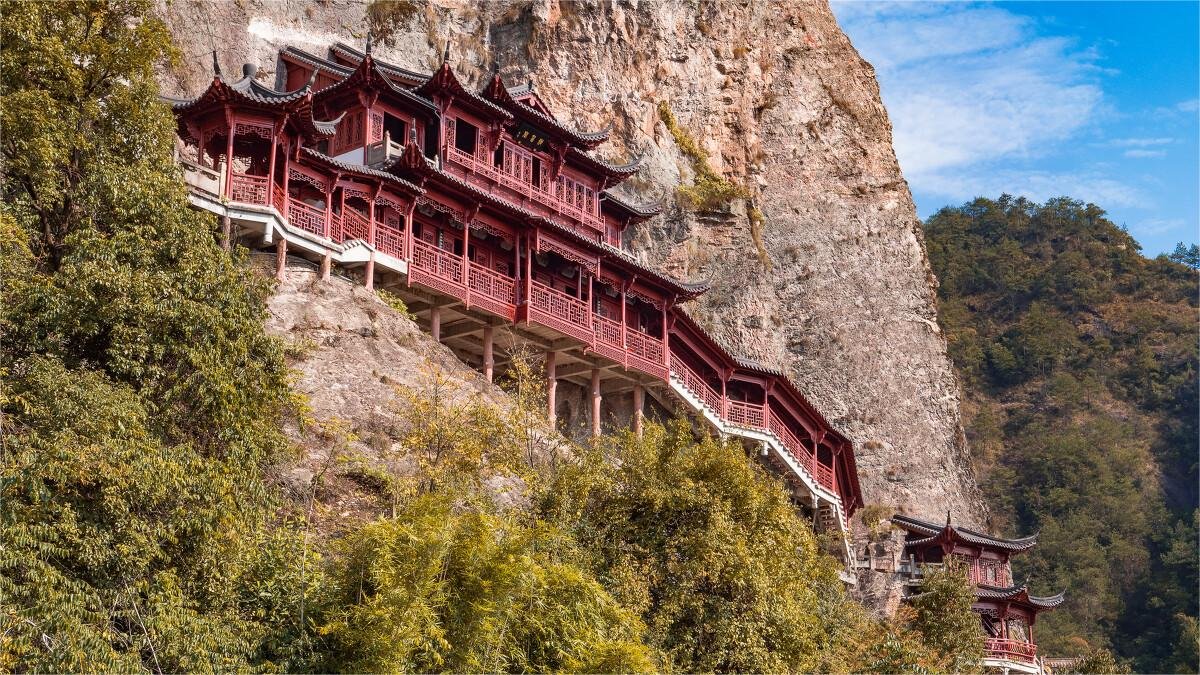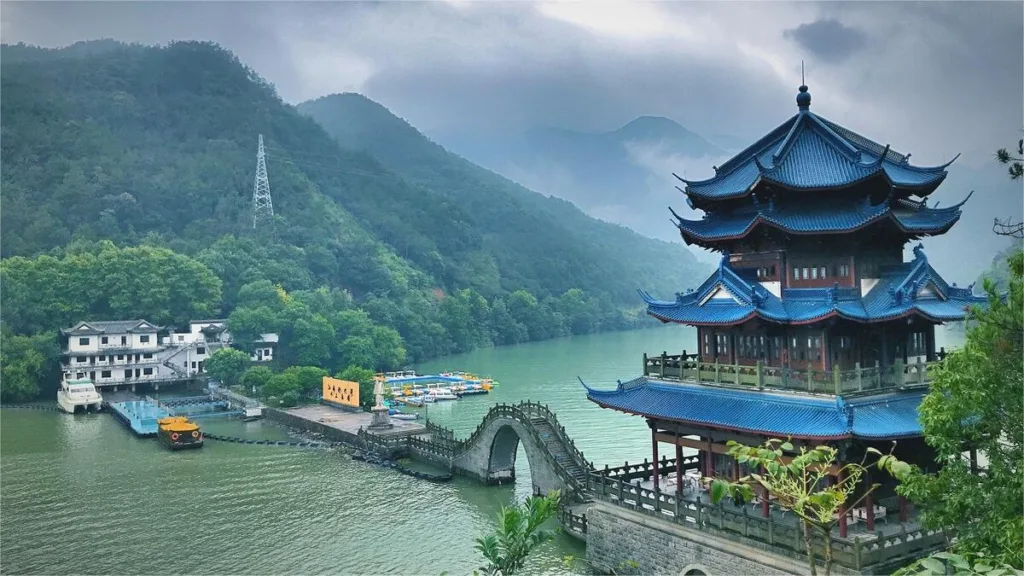Daci Cliff (大慈岩), located in Jiande City, Hangzhou, is a picturesque tourist destination renowned for its blend of Buddhist culture and stunning natural scenery. Often referred to as the “Little Jiuhua Mountain of Zhejiang,” it is famous for its hanging temple, Changgu Valley Stream, and the first natural standing Buddha in China. Throughout the area, there is a prevalent sense of “hanging”, with pathways, temples, and the giant Buddha statue clinging to steep cliffs. While much of it has been reconstructed, it still astounds visitors with the ingenuity of ancient builders.
The typical route for touring Daci Cliff forms a circular path. Visitors are recommended to take the cable car up the mountain and then walk downhill clockwise, which saves time and energy. The joy of the visit lies in strolling along winding paths along the cliff edge, admiring the trails, temples, and Buddha statues nestled in the mountainside, as well as the sprawling green hills and tiny towns below in the distance. The scenery is truly spectacular and offers a unique perspective on the natural and cultural beauty of the region.
Table of Contents
- Basic Information
- Location and Transportation
- Highlights of Daci Cliff
- Vlog about Daci Cliff
- Other Attractions in Jiande
Basic Information
| Estimated Length of Tour | Half a day |
| Ticket Price | 80 RMB |
| Combined Ticket | Admission + Cable Car Upward: 160 RMB |
| Opening Hours | 8.00 – 16.00 |
| Telephone Number | 0086-0571-64549418 |
Location and Transportation
Daci Cliff is located 24 kilometers south of Jiande City in Hangzhou, Zhejiang Province. To reach this destination, visitors can first take a high-speed train to Jiande Railway Station. From there, they can transfer to a tourist special bus heading to Xinye Ancient Village, which stops near the entrance of Daci Cliff. The tourist bus departs at 10:30 AM and 2:30 PM.
Highlights of Daci Cliff
Cliffside Cave Temples

One of the most striking features of Daci Cliff is its cliffside cave temples. The main temple, dedicated to the Bodhisattva Ksitigarbha, is built within a 3-meter-high cave that stretches 60 meters long and 20 meters wide. Half of the temple hangs precipitously over the cliff, while the other half is embedded into the rock face, creating a dramatic and awe-inspiring sight reminiscent of the Hanging Temple of Mount Hengshan in Shanxi Province. Another newly constructed temple, Qingfeng Pavilion, is perched high above the steep cliff, offering panoramic views of the surrounding mountains and rivers. The recently carved “Heavenly Pathway” follows the contour of the cliff, forming a long corridor of interconnected stone balustrades. Standing at the railing, visitors may feel as if they are on the verge of stepping off into the abyss below.
Changgu Valley Stream

Another distinctive feature of Daci Cliff is the Changgu Valley stream. The mountainous terrain of Daci Cliff creates numerous cascades and waterfalls as the stream flows down from the mountaintop lake of Yuhua. The water meanders through the valley, sometimes blocked by large rocks to form streams, or cascading over cliffs to create waterfalls. Springs emerge among the scattered rocks, adding to the charm of the landscape. The winding stream stretches for over 800 meters, creating a picturesque scene of mountains and water.
Natural Standing Buddha

Daci Cliff is also home to the largest natural standing Buddha in China. When viewed from the side, the main peak of Daci Cliff resembles a standing statue of the Bodhisattva Ksitigarbha. Standing at a height of 147 meters, the statue’s head measures 41.3 meters tall and 60 meters wide. It is formed by a combination of unique rocks, unusual caves, and harmoniously arranged vegetation, creating a lifelike representation of the Buddha’s features. This natural wonder is hailed as a masterpiece of Chinese landscape and is celebrated in the book “China’s Superlatives.” Daci Cliff’s unique natural landscape has garnered widespread acclaim and made it a renowned destination both domestically and internationally.





